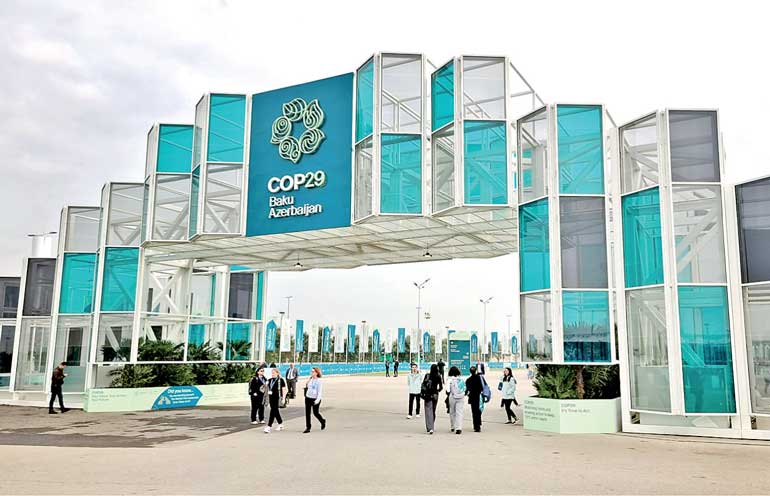Thursday Dec 18, 2025
Thursday Dec 18, 2025
Saturday, 30 November 2024 00:26 - - {{hitsCtrl.values.hits}}

 After two weeks of negotiations in Baku, Azerbaijan, COP29 ended at 5:30 a.m. during a closing plenary that lasted through the night from Saturday to Sunday, 24 November, almost two days after the scheduled closing of the sessions. Key negotiation items included climate finance and adaptation, among many others: but what are some of the main outcomes, and where does the world go from here?
After two weeks of negotiations in Baku, Azerbaijan, COP29 ended at 5:30 a.m. during a closing plenary that lasted through the night from Saturday to Sunday, 24 November, almost two days after the scheduled closing of the sessions. Key negotiation items included climate finance and adaptation, among many others: but what are some of the main outcomes, and where does the world go from here?
The global climate negotiations
“COP29” is shorthand for the 29th meeting of the Conference of the Parties to the United Nations Framework Convention on Climate Change (UNFCCC), as well as the concurrent meetings of Parties to the Paris Agreement and the Kyoto Protocol. Since 1995, a COP was held every year except 2020, when the COVID-19 pandemic prevented the meeting. As agreed between countries, the location of the COP is subject to regional rotation, with this year’s COP filling the Eastern Europe slot, and next year’s COP (COP30) taking place in Bélem, Brazil, in the Latin American and Caribbean region.
With 198 Parties to the UNFCCC and 195 Parties to the Paris Agreement, these climate negotiations bring together almost all countries of the world. Tens of thousands of delegates from countries, nine official observer constituencies, and other stakeholders came together from 11 to 24 November 2024, to engage on a broad range of agenda items, including finance, mitigation, adaptation, loss and damage, just transition, and technology.
A new goal for climate finance
Branded as a “finance COP,” the question of climate finance took centre stage at COP29 and influenced almost everything happening across the Baku Olympic Stadium, which had been transformed into a sprawling conference venue by the host country, Azerbaijan.
While there were roughly 20 agenda items related to finance, the main spotlight was on the new collective quantified goal for climate finance, commonly abbreviated as “NCQG.” This new goal is meant to replace the current commitment from developed countries to collectively provide $ 100 billion of climate finance per year to developing countries between 2020 and 2025.
Key issues surrounding the NCQG included the overall amount (the “quantum”), quality, and sources of finance provided, as well as transparency, reporting, timeframes, and a host of other considerations.
In tense negotiations that lasted until the final hours deep in the night on 24 November, Parties finally agreed on a common landing ground and came to a decision, albeit one that left many countries frustrated and disappointed.
The goal is set at a minimum of $ 300 billion per year by 2035, for which developed countries are supposed to “take the lead,” but which will come from “a wide variety of sources, public and private, bilateral and multilateral, including alternative sources.” In addition, the decision also calls on all actors “to work together to enable the scaling up of financing to developing country Parties for climate action from all public and private sources to at least $ 1.3 trillion per year by 2035.”
As outlined in the decision text, the current provision of finance is inadequate compared to the vast needs, resulting a gap. The decision states that the costed needs of developing countries to implement their Nationally Determined Contributions (NDCs)—the respective climate actions they plan to take at the national level—total $ 5.1–6.8 trillion for up until 2030, or $ 455–584 billion per year, with adaptation finance needs estimated to be around $ 215–387 billion annually up until 2030. It also “notes with concern the gap between climate finance flows and needs, particularly for adaptation in developing country Parties.”
While $ 300 billion presents a nominal tripling of the previous goal, it falls behind the needs and expectations of developing countries and many observers. Over the next years and on the road to 2035, a lot of work remains to be done to build on the COP29 decision and ensure that climate finance is scaled up to meet the needs of vulnerable developing countries, enabling them to take ambitious climate action towards achieve the goals of the UNFCCC and the Paris Agreement.
Towards a global goal on adaptation
The goals mentioned above include the reduction of greenhouse gas emissions (“climate change mitigation”) to avoid a further global temperature rise and keep climate change at bay. However, the Paris Agreement also established a Global Goal on Adaptation (GGA), which serves as a counterpart to the overarching temperature goal of 1.5 degrees Celsius.
As highlighted in the NCQG decision, the finance gap not only affects mitigation but also the increasingly important area of adaptation. As the impacts of climate change begin to mount and affect countries and communities across the globe, urgent action is needed to adapt to them and build robust systems for risk management and long-term resilience to avoid the worst losses and damages.
The GGA is supposed to help countries work towards this and provide a framework for global adaptation action. In 2023, this framework was launched with seven thematic targets on food, water, health, ecosystems, infrastructure, livelihoods, and cultural heritage, as well as fo8r additional “dimensional” targets related to the process of adaptation planning.
COP29 saw progress towards the operationalisation of the GGA framework, as it outlines the way forward on the identification or development of indicators for each of the targets. From COP29 onwards, technical experts will work on breaking down a long list of compiled indicators and making recommendations to Parties, who will then have to make a final selection but also decide on how these indicators are to be used, measured, and reported on.
The COP29 negotiations also explored a range of other considerations related to the GGA, such as its linkages to the Global Stocktake, the role of different stakeholders, or the concept of transformational adaptation. In addition, connections to other adaptation agenda items—such as National Adaptation Plans—could also be further explored to strengthen the framework and modalities for implementation of the GGA.
Looking ahead beyond COP29
COP29 is over, and already, the world is turning towards COP30 at the end of 2025, as well as the intermediate negotiations in June in Bonn, Germany. Besides finance and adaptation, several other decisions have been made in Baku that set a roadmap for the next year, with some topics being pushed forward to Bonn or Bélem for further consideration.
While negotiations and technical work will continue at the global level, there is also an important role to be played by countries and other national and local actors, who can align their policy processes, generate evidence, build capacities, and boost global awareness and momentum for decisive climate action.
(The writer works as Director: Research & Knowledge Management at SLYCAN Trust, a non-profit think tank based in Sri Lanka. His work focuses on climate change, adaptation, resilience, ecosystem conservation, just transition, human mobility, and a range of related issues. He holds a Master’s degree in Education from the University of Cologne, Germany and is a regular contributor to several international and local media outlets.)